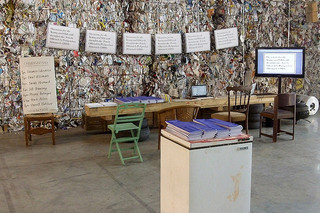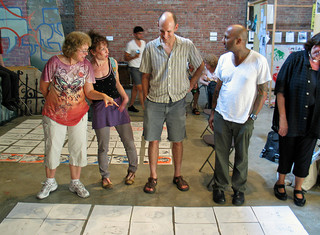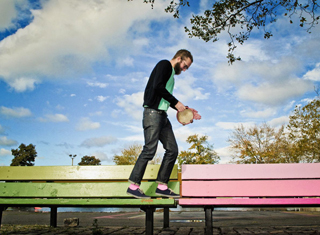Artist-founded and administered schools have existed for over a century. In 1875, a group of artists pinned a notice to the bulletin board of the National Academy of Design inviting students and instructors to attend a meeting, effectively founding The Art Students League in New York City. In 1919, the German architect Walter Gropius started Bauhaus, an institution that merged fine arts and applied arts in pursuit of the “gesamtkunstwerk” (total work of art). His manifesto declared:
Let us strive for, conceive and create the new building of the future that will unite every discipline, architecture and sculpture and painting, and which will one day rise heavenwards from the million hands of craftsmen as a clear symbol of a new belief to come.
And in 1933, the scholar John A. Rice began the experimental Black Mountain College in North Carolina. It was owned and operated by its faculty, which included artists, musicians and poets such as Josef Albers, Buckminster Fuller, John Cage, Merce Cunningham and Charles Olsen. The school believed in an interdisciplinary approach to education and combined communal living and farm work with classwork.
Over the past five years or so, there’s been a resurgence of artist-operated schools. However, what differentiates these new exploratory educational practices from their historical predecessors is that the schools themselves are also the art, framed as participatory, collaborative community projects. Rather than using physical materials to construct a work that may comment on a social condition, the artists use language, thought and action to construct social spaces. Their art schools destabilize one’s notion of a school by placing it in a museum, a house, a park or a gallery while asking participants to work collaboratively, creating a shared sense of space. There’s precedent for this: Joseph Beuys first coined the term “social sculpture” in the 1960’s to describe interdisciplinary and participatory action-based work. Let’s take a look at some of these art schools as artworks:
The Bruce High Quality Foundation University
Founders: The Bruce High Quality Foundation, a mostly anonymous New York City-based arts collective. Most of the Bruces met while studying at Cooper Union.
Sample Course Offerings: “BYOU (Build Your Own University),” “Drawing Extensions,” “The Language of Love: Intro to Italian” and “XXXTreme Performance Studies”
Cost: Free
The Gist: Embracing a collaborative learning model where “students are teachers are administrators are staff,” the BHQFU claims to be “a community of scholars” and “a ‘f*** you’ to the hegemony of critical solemnity and market-mediocre despair.”
Founders: Artists Mark Dion and J. Morgan Puett
Sample Course Offerings: “Attention Labs with The Order of the Third Bird” and “PondHouseSpringHousePond”
Cost: $3000 (includes room and board)
The Gist: “Life is a studio” in this northeastern Pennsylvania communal art space where participants live and “collaboratively work with internationally renowned artists” who direct each session. An iteration of the working-living-researching-making environment is included in the Museum of Modern Art Education Department’s MoMA Studio, and, through discussions, meals and other interactions, “invites visitors to explore inventive forms of domesticity, tactile qualities related to textiles and the natural states of food.”
Founder: Contemporary art curator Joseph del Pesco
Sample Course Offerings: “Celebrating Dilettantism,” “Revolutionary Experimental Cinema in the Bay Area” and “Do-It-Yourself, Together”
Cost: Free
The Gist: “An experimental school-without-walls,” commissioned by the San Francisco Museum of Modern Art in 2009-10, curriculum used existing lectures, screenings, workshops and other public events in the Bay Area as its starting point, and then took them “out of context” for a new “thematic frame” and “unexpected discoveries.” Discussions happened online.

Anton Vidokle’s “Exhibition as School” including “Night School” archives
Photo by Knoxville Museum of Art
Founder: Artist and e-flux founder Anton Vidokle
Sample Course Offerings: seminars led by Boris Groys, Martha Rosler and Liam Gillick
Cost: Free
The Gist: Part of Vidokle’s series of temporary school projects, this iteration was hosted by New Museum in 2008. The program included a lecture series open to the public as well as additional workshops and discussions for a core group of 26 accepted applicants.
The “Skool of Refuse and Appropriation” at The University of Trash
Founders: Michael Cataldi and Nils Norman
Sample Course Offerings: “How to Stay Free,” “Supersede Yourself” and “Freeing the Airwaves from Corporate Control”
Cost: Free
The Gist: free and open to the public during summer 2009, the temporary, makeshift university as exhibition hosted lectures, workshops and screenings. Resources included stages, a low power FM radio station, internet, hammocks and a grill, and participants were invited to “teach a class, hold band practice, contribute to zine library or propose any project!”
Founders: Artists Cassie Thorton and Chris Kennedy
Sample Course Offerings: “Mutant Student Groups Think Tank,” “Compost Brigade,” “Philosophy Yoga,” and “Gender, Identity and Making Mustaches”
Cost: Free
The Gist: The “un-school” was first an “outdoor intergenerational free school” run by artists, activists and teachers in industrial north Brooklyn. It has since become “an archive of lessons learned and a network of radical educators who question our current forms of education.”
Founders: OurGoods co-founders Louise Ma, Rich Watts and Caroline Woolard
Sample Course Offerings: “Pilates in a Chair,” “Caviar: Demystified,” “Portrait Photography “ and “Baudrillard Camp: Media Theory vs Literary Criticism”
Cost: Participants pay for classes by bartering goods and services
The Gist: “Trade School celebrates practical wisdom, mutual respect and the social nature of exchange” and has been endorsed by socially-engaged-art heavyweight Pablo Helguera. They recently participated in Parsons’ Art, Environment, Action!“creative teaching laboratory and environmental ‘artshop.’”
Founder: Graphic designer and artist Mike Perry
Sample Course Offerings: “IMAG(in)ING the CITY,” “Never Nude!” and “Mega Zine”
Cost: Free
The Gist: Graphic Designer Mike Perry created a free three-month “exhibition and community event space” to coincide with the launch of his monograph. Perry and other designers conducted workshops, screenings, gatherings and open discussions where visitors could “explore freely and create their own unique experiences.”
*
Some of these education-as-art projects, most notably the Bruce High Quality Foundation University, have been posited or lauded as progressive and practical alternatives to the increasingly expensive Master of Fine Arts (MFA) education from accredited art colleges and universities. The Bruces explain:
Something’s got to give. The $200,000-debt-model of art education is simply untenable. Further, the education artists are getting for their money is mired in irrelevance, pushing them into critical redundancy on the one hand and professional mediocrity on the other.
Could programs such as these eventually replace our current institution-centric paradigm? I find the premise somewhat disingenuous and unrealistic. Many of the participants of the alternative art schools are either current MFA candidates, or have already received an MFA. And many of the lecturers or faculty are also faculty at universities—they’ve hardly rejected the academy. What’s more, the rigor of the course offerings for the art-school-projects wildly fluctuates, from seminars on Marxism to analyzing the dim sum offerings in Chinatown. Although the latter is interesting and arguably, the ability to differentiate between dumplings is a far more practical skill than being able to pontificate on the finer points of Foucault, it’s also not something one could receive credit for in graduate school. Finally, regardless of the intellectual and instructional level of materials, in all of these programs, there’s no consequence for failing to complete the homework or not engaging in a discussion. No degree is withheld, because there are no degrees.
And of course, this is the point. These art schools offer a re-imagining of our arts educational system. Yet, so many of the artists involved in these projects have formal arts degrees and continue to have positive relationships with traditional academic institutions—as faculty, guest lecturers and even students, that it’s difficult for me to trust that they genuinely believe in their institutions as replacements for the current model. Their true purpose is not as higher-ed replacement, but as an exploration of art’s value in a learning environment.
In this sense, these art schools as art projects are the purest form of education— the reward for one’s efforts is not a certificate, but instead, learning. In fact, that’s why these new alternative art schools are most intriguing. Unlike their historical predecessors, they aren’t meant to replace the art college/university model. In part, that’s why these new art schools are also artworks. They are social sculptures where pedagogy is a means to another end—participatory, socially engaged, community based art projects, education as exhibition.






